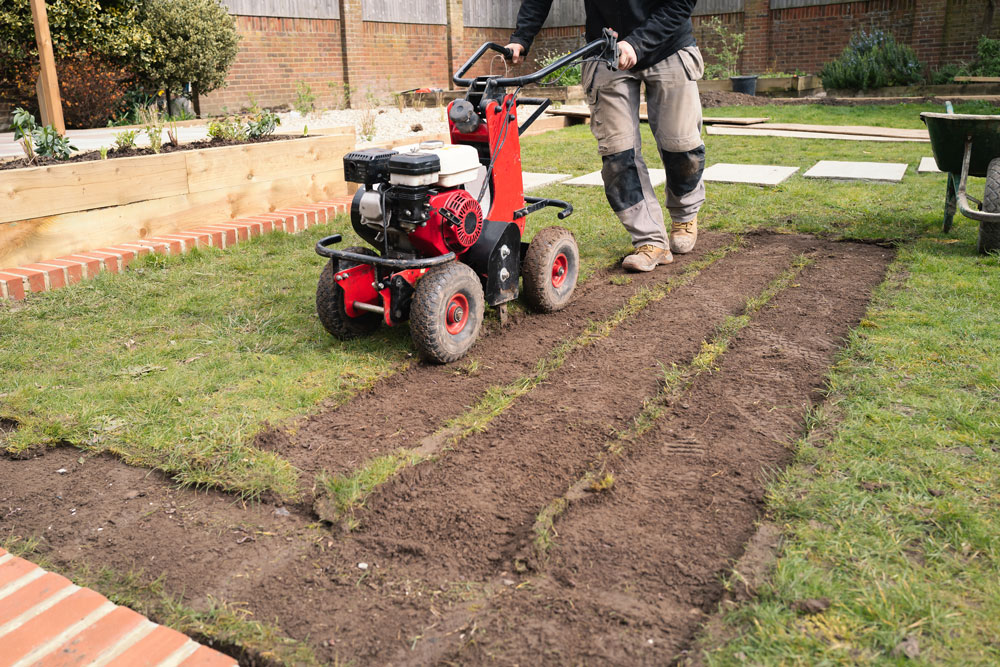Posted: 8th September 2023 | Author: Jamie Brown
Back to news

Laying artificial grass can be an excellent way to upgrade your outdoor area with a naturalistic look that doesn’t take up all your time to maintain. But if you’re planning to install artificial grass in your garden, you’ll need to prep the area - and what that entails differs depending on what’s already there.
Adding artificial grass to a concrete ground is a great way to make your outdoor space look more natural and welcoming without taking on a hefty landscaping task to return it to natural turf. It’s less hassle to maintain and could add value to the property both for you and for potential buyers in the future.
But how do you prepare concrete for artificial turf?
The first thing you need to do is clean the surface of the concrete. Removing dirt and debris will help the adhesive to stick well when the turf is laid. You’ll also need to remove moss and weeds - and if these have been a problem in the past, it’s a good idea to apply weedkiller to tackle them.
If your concrete surface has lots of lumps and bumps or big cracks, you might also benefit from using a self-levelling compound to flatten it out. Once this has set, wash it again to make sure you have a clean surface. If water pools in certain areas, you’ll need to add drainage holes in those places and fill the holes with 10mm shingle. This ensures you won’t end up with standing water after a downpour.
Once you’re happy that your surface is draining well and is clear of any weeds or debris, you’ll need to add a foam underlay, glued down with an outdoor-safe adhesive. This creates a softer, more spongy surface underneath the artificial turf, making it more pleasant to walk on. It’s also a bit safer to fall on, so it’s especially important if you know small children or people with impaired mobility who might wish to go on the grass.
Top tip! Roll out the underlay to cover the whole surface and cut it to fit before glueing anything down. As always, check your measurements twice before you make a cut.
Laying artificial turf on paving slabs is very similar to doing so on concrete, as you’ll need to carry out all the same steps. Make sure the surface is clean and level, check the drainage and add a layer of soft foam underlay to cushion the surface below the turf.
Paving slabs often have an uneven surface as the mortar between the slabs wears away over time. If the gaps are small, you can usually fill them in with sharp sand before applying a self-levelling compound. If the gaps are more significant, it may be best to fill them in with quick drying cement. Always make sure this is fully dry before moving onto the next stage.
Perhaps you already have a lawn, but maintaining it is taking up too much of your precious time. If that’s the case, you’ll be pleased to know that you can lay artificial grass on an existing lawn - but you’ll have to prepare the area first.
Although we’ve described it as laying artificial grass on existing grass, you’ll need to remove the existing turf to do this. If you have a small garden, you might be able to do this with a spade, but for larger gardens, a turf cutter is recommended. You’ll want to dig down to about 40 to 50mm to accommodate for the height of your new turf. Then clear the area. Any plant pots, kids’ toys or garden furniture should be moved well out of the way. You might also want to cut back any overhanging hedges or bushes for ease of access.
Next, you’ll need to add an edging. Without this, the pressure of walking on the grass will shift the sub base (which you’ll add later), leaving you with an uneven, uncomfortable surface. Whether you use timber, brick, tiles or stone is up to you, but a good edging should be sturdy enough to act as a dam against shifting aggregate.
Once your edging is secured, it’s time to add the sub base. This should be made up of type 1 aggregate, laid to a thickness of roughly 30 to 40mm. Make sure to calculate how much aggregate you need beforehand so you don’t find yourself short when you lay it out. Then add a layer of sharp sand of about 10 to 15mm to level out the surface. Finally, add a protective membrane to prevent weeds from growing through your turf.
With that done, you’re all set to have your artificial grass of choice installed.
Back to news
The Author: Jamie Brown
From my early working life as a labourer, then becoming a builder and a property developer, I have been buying and using building materials for over 25 years. I set about to start a builders merchant which can offer high-quality products and significant savings along with speedy delivery to keep your sites moving. Still having a foot in the construction industry on my own property, I always make sure the products we sell are up to our high standards which is important for us to keep a great image for the company and superior reputation to supply quality!